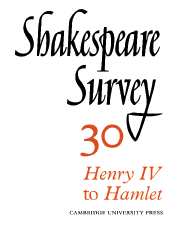Book contents
- Frontmatter
- ‘Henry IV’ and ‘Hamlet’
- Prince Hal and Tragic Style
- The True Prince and the False Thief: Prince Hal and the Shift of Identity
- Falstaff, the Prince, and the Pattern of ‘2 Henry IV’
- Whatever Happened to Prince Hal?: An Essay on ‘Henry V’
- ‘Henry V’ and the Bees’ Commonwealth
- ‘All’s Well that Ends Well’
- ‘Hamlet’ and the Power of Words
- Hamlet the Bonesetter
- ‘Hamlet’: A Time to Die
- Shakespeare, Lyly and Ovid: The Influence of ‘Gallathea’ on ‘A Midsummer Night’s Dream’
- Making a Scene: Language and Gesture in ‘Coriolanus’
- Freedom and Loss in ‘The Tempest’
- Inigo Jones at The Cockpit
- Theory and Practice: Stratford 1976
- The Year's Contributions to Shakespearian Study 1 Critical Studies
- 2 Shakespeare’s Life, Times, and Stage
- 3 Textual Studies
- Index
- Plate Section
Whatever Happened to Prince Hal?: An Essay on ‘Henry V’
Published online by Cambridge University Press: 28 March 2007
- Frontmatter
- ‘Henry IV’ and ‘Hamlet’
- Prince Hal and Tragic Style
- The True Prince and the False Thief: Prince Hal and the Shift of Identity
- Falstaff, the Prince, and the Pattern of ‘2 Henry IV’
- Whatever Happened to Prince Hal?: An Essay on ‘Henry V’
- ‘Henry V’ and the Bees’ Commonwealth
- ‘All’s Well that Ends Well’
- ‘Hamlet’ and the Power of Words
- Hamlet the Bonesetter
- ‘Hamlet’: A Time to Die
- Shakespeare, Lyly and Ovid: The Influence of ‘Gallathea’ on ‘A Midsummer Night’s Dream’
- Making a Scene: Language and Gesture in ‘Coriolanus’
- Freedom and Loss in ‘The Tempest’
- Inigo Jones at The Cockpit
- Theory and Practice: Stratford 1976
- The Year's Contributions to Shakespearian Study 1 Critical Studies
- 2 Shakespeare’s Life, Times, and Stage
- 3 Textual Studies
- Index
- Plate Section
Summary
E. M. W. Tillyard is right in his assertion that Shakespeare in Henry V was ‘jettisoning the character he had created’ in the Henry IV plays. The Hal that developed out of those earlier histories is not present at the opening of Henry V. This does not mean that Shakespeare has now accepted a Henry ‘who knew exactly what he wanted and went for it with utter singleness of heart . . .’ Nor has he, as Mark Van Doren would have us believe, stretched a hero ‘until he struts on tiptoe and is still strutting at the last insignificant exit.’ Nor, on the other extreme, is Henry the ideal humanistic hero, ‘conceived of as beyond the limitations of nature, able to impose the order of philosophy on the protean world of history.’ Rather, as H. M. Richmond notes, Henry in this play begins as a ‘clever young hero masquerading as the ideal king’, and ends as ‘a mature man’. Thus the process of growth that Henry undergoes in the play is crucial. While this process may render the second tetralogy inconsistent, it gives a marked consistency to the play Henry V as it stands alone. For in it Shakespeare has decided to dramatize again the maturation of a ruler. He is repeating, for the purposes of effective drama – the play is meant to be presented by itself – the pattern of the education of a prince shown in the previous Henry IV histories. Critical confusion arises when this Henry is expected to be identical to the Henry who rejects Falstaff in Henry IV. Rather, the king is a character very much like Hotspur as the play begins.
- Type
- Chapter
- Information
- Shakespeare Survey , pp. 47 - 60Publisher: Cambridge University PressPrint publication year: 1977
- 1
- Cited by



